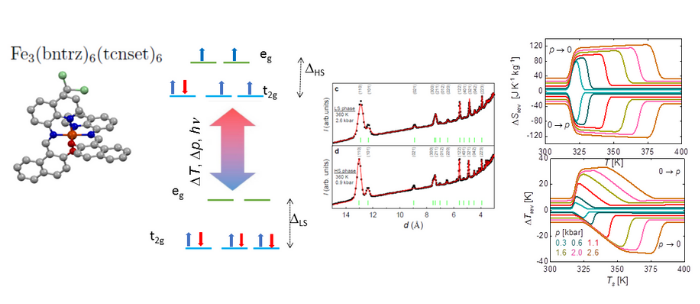
Figure. From left to righ: 3D model of trinuclear metal complex Fe3(bntrz)6(tcnset)6; Schematic illustration of SCO for a transition metal ion with d6 electronic configuration. The transition can be induced by changes in temperature (∆T), pressure (∆p) or light irradiation (hν); Isothermal (T = 360 K) powder diffraction patterns at p = 2.6 kbar (c) and p = 0.9 kbar (d); Reversible isothermal entropy changes (∆S) on decompression and compression as a function of temperature at different pressures. Reversible adiabatic temperature (∆T) changes on decompression and compression as a function of temperature at different pressures.
Cerdanyola del Vallès, 3 February 2021. The study of materials with giant caloric effect (reversible thermal changes induced by an external stimulus), is currently a hot topic in Materials Science since they are the best-placed candidates to develop new efficient and environmentally friendly refrigerators that must replace current devices, which feature low efficiency and use hazardous fluids.
Extensive research has shown that the caloric effects in solid-state materials can be triggered by various external stimuli: magnetic field (magnetocaloric effect), electric field (electrocaloric effect), uniaxial stress (elastocaloric effect), hydrostatic pressure (barocaloric effect) or a combination of different stresses.
While magnetocaloric and electrocaloric effects require magnetically or electrically polarized materials, barocaloric effects can be found in any compressible material, which make them more interesting.
There is therefore a need to find out caloric materials exhibiting both large isothermal entropy and adiabatic temperature changes, for which these changes are reproducible upon cyclic application and removal of hydrostatic pressure.
A research, recently published in Advanced Materials, studies the barocaloric properties of Fe3(bntrz)6(tcnset)6, a molecular material that contains a metal complex that undergoes an abrupt spin-state switching (spin-crossover transition) close to room temperature. The work was carried out by a team from the Universitat de Barcelona (Spain), the Universitat Politècnica de Catalunya (Spain), the Florida State University (USA), the University of Science and Technology Beijing (China) and the Ankara University (Turkey), in collaboration with the ALBA Synchrotron.
Results show that the barocaloric performances for this material largely outperform those previously reported for spin-crossover compounds and most barocaloric materials. In contrast to many caloric materials, the outstanding isothermal entropy (ΔS) and adiabatic temperature (ΔT) changes are found to be reversible for low values of the applied pressure, over a broad temperature range, underscoring the potential practical value of this barocaloric material.
X-ray diffractions patterns were collected as a function of hydrostatic pressure and temperature at the MSPD beamline of the ALBA Synchrotron. Using the patterns recorded at selected temperatures researchers determined the temperature dependence of the unit cell parameters and volume, which exhibit a sharp change at the spin –crossover (SCO) transition.
The volume thermal expansion in the vicinity of the SCO transition was determined for both high spin and low spin states.
Broadening knowledge of previous researches
Very recently, a family of organic compounds - also studied at ALBA - have been reported to exhibit entropy changes with values that compare well to those for the refrigerant fluids used in commercial refrigerators. Despite this important achievement, the adiabatic temperature changes of these materials are still moderate.
A very important drawback for future applications of these newly reported barocaloric materials into devices, is the restricted reproducibility of the colossal effects upon pressure cycling, due to a significant thermal hysteresis of the phase transition leading to the barocaloric effect.
These findings are expected to have a strong impact in the research fields of organic molecular magnets, and giant caloric materials. They will stimulate further research on the barocaloric effects observed in spin-crossover materials, especially in terms of identifying and designing principles that can lead to abrupt but non-hysteretic spin transitions.
Reference: Michela Romanini, YiXu Wang, Kübra Gürpinar, Gladys Ornelas, Pol Lloveras, Yan Zhang, Wenkai Zheng, Maria Barrio, Araceli Aznar, Adrià Gràcia‐Condal, Baris Emre, Orhan Atakol, Catalin Popescu, Hu Zhang, Yi Long, Luis Balicas, Josep Lluís Tamarit, Antoni Planes, Michael Shatruk and Lluís Mañosa. Giant and Reversible Barocaloric Effect in Trinuclear Spin-Crossover Complex Fe3(bntrz)6(tcnset)6. Advanced Materials. DOI: 10.1002/adma.202008076




